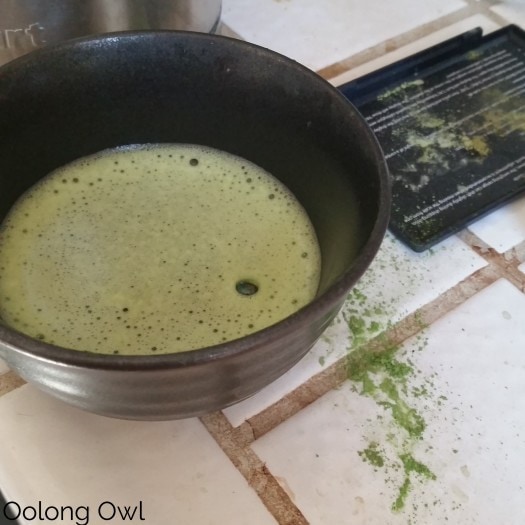I recently finished doing some matcha tasting work. Matcha has been on my mind a lot as matcha is the big trend now. Tea companies are pushing it, adding weird flavors it it (cheese pizza matcha yo), and selling it as magical cure to all your problems. I’ve been reviewing it and tea companies that aren’t exclusive matcha sellers are scratching their heads wondering if there matcha is any good and scrambling to find better. I’ve drank so much matcha this year that it is simply crazy and potentially damaging to my body.
I also been drinking so much matcha I still keep finding piles of matcha dust throughout my kitchen.

The big thing I’ve seen drama on is this: Matcha is only from Japan. If the stuff is from outside Japan it is green tea powder.
Okay fine then, a treatment similar to regional specific names like some cheeses or wines. Unfortunately this region specific thing isn’t enforced. The terminology switch is a headache as the prototype term for the general population mind is anything that is powdery green fluff is matcha. Legal action would have to be made or all of us would have to get out our sharpened matcha whisks storming the internets to enforce matcha/green tea. Latter wouldn’t make a difference – the matcha miracle cures tea sellers have been out for awhile now and SEO matters.
Next rant: Japanese Matcha is the real thing, thus tastes the best.
The bulk of this Tea Hoot rant is this Japanese Matcha tastes the best drama. With all my matcha tastings, I had a lot of Chinese matchas, a few Taiwanese and of course Japanese.
1. Transparency. A disappointing thing I noticed is only a handful of tea companies have full disclosure on their matcha. Where the tea farm is, what tea was the base (Japanese matcha should be tencha, which is only made into matcha), and what year/season it was made? The rest of the companies…. who knows? For all we know the matcha could be Japanese processed but the material could be grown in a poopy conditions tea field in another country. Do you know what your matcha is? At minimum I like to see 1. Production month/season + year. 2. Material. 3. Country of Origin. 4. Grade.
2. Other regions make great tea. Another thing I noticed is I’ve tasted some great Chinese matchas. It is truly if you got a great tea as a base it makes great tea. Not all green tea tastes the same thus if a different green is used the flavor of matcha will change. During my tastings I started to associate the taste of Japanese matchas as grassy, creamy, toasty rice, nutty, kelp and savory unami. I had one Chinese matcha that tasted grassy, creamy, unami and nutty – I was surprised it was a Chinese matcha! One Chinese matcha I had was really set apart as it was sweet and had a great amount of floral in it – very delicious! An important tea drinking lesson – buy samples to try everything before you buy a full size.
As matcha gets bigger, and sellers get creative, we could see new teas sold as powder and new tastes. Maybe better tastes. Tastes that may suit you more than traditional tastes. It’ll be no different than how some of us prefer a Chinese blacks or Indian grown black teas. With that said, we shouldn’t discount matcha/green tea powder from another region.
3. There’s crappy Japanese Matcha. I said it. Back to when I said I was tasting for a tea company. I’m trying all Japanese origin matchas. There is one matcha in particular – it looks pretty, a vibrant fluffy green. It whisks up green, foamy and pretty.
Taste? It wasn’t tea. I bet I could replicate this matcha’s taste if I scrape up what is in the my lawn mower of dead weeds, add some green dye, and some soap to foam it. It is back to transparency again – what the heck is this matcha? I’m pretty sure it is not Camellia sinensis content. It is Japanese but I guess it’s Japanese weeds? Maybe it was made in some food lab in Japan? There were some other matchas I tried that were also pretty bad – ones that also tasted like there was soap and thickeners. The soap ones are funny as they bubble up big and have a rainbow sheen on it like I’m going to take a bubble bath in it. Other matchas were very chalky, leaving me to believe I’m probably drinking green paint and chalk.
Looks legit.. however tastes like sadness.

That said, another reminder of the important tea drinking rule – always buy samples first!






